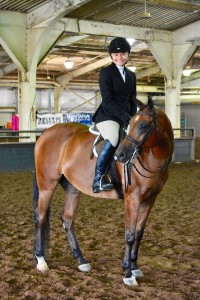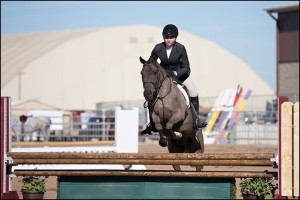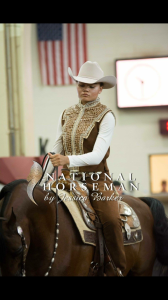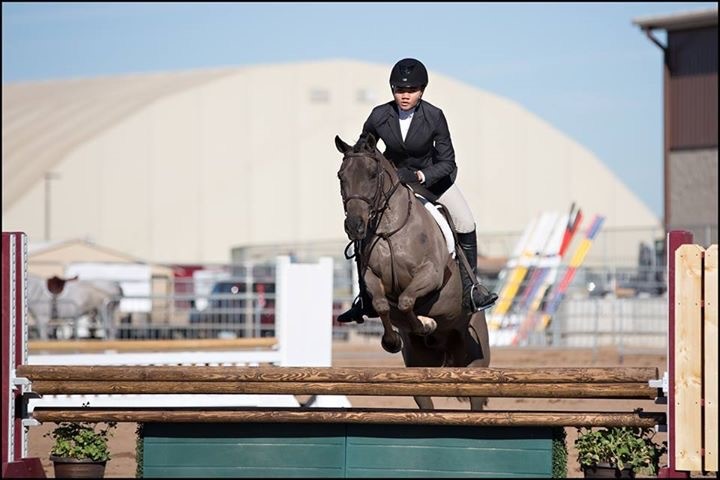By Jasmyn Genchev
Our futures can change in unpredictable ways. But, sometimes it’s the simple, unexpected things that can change our lives forever. This is very much the case for TPA senior Kierstin Thigpen, who stumbled across an extraordinary animal one day while visiting her best friend’s backyard.
 Kierstin first started riding horses when she was in kindergarten. She never really had any experience with horses at the time, but after seeing several while at a friend’s house, she was immediately and completely intrigued by them. Over the next few years, Kierstin found herself constantly helping her friend’s family with barn chores, grooming, and of course lots and lots of riding, until she was able to get professional lessons of her own four years later.
Kierstin first started riding horses when she was in kindergarten. She never really had any experience with horses at the time, but after seeing several while at a friend’s house, she was immediately and completely intrigued by them. Over the next few years, Kierstin found herself constantly helping her friend’s family with barn chores, grooming, and of course lots and lots of riding, until she was able to get professional lessons of her own four years later.
Kierstin claims that “the best part of riding is the relationship that I’m able to build with each new horse that I work with. Whether I’m riding or simply working on the ground, every horse has a different personality with new lessons to teach.”
With the help of her new trainer, Kierstin began competing in a few local horse shows, progressively improving her skill. Eventually, her trainer started an internship with the highly acclaimed Arabian Sport Horse trainer, Jackie Alkin, introducing Kierstin to the Hunter/Jumper and Dressage world and giving her the amazing opportunity to compete at the regional and national levels with very high-quality horses from Cow Ponies to Show Jumpers.
She has competed all the way from local, C-Level shows to the more elevated regional, national, and international level competitions. But the most renowned show that she has competed in is the Scottsdale Arabian and Half-Arabian Horse Show. This impressive competition hosts riders from all over the world to show off their horses and skills. Not only has Kierstin just made it to these widely known championships but she has also had great success, earning multiple top-ten, reserve champion, and champion awards at the regional and national levels in Hunter Pleasure, Huntseat Equitation, Working Hunter Over Fences, Western Pleasure, Sport Horse Under Saddle, and Sport Horse In-Hand.
 Kierstin says that her most memorable experience was at this year’s Arabian and Half-Arabian Youth Nationals in the Huntseat Equitation going on her third year of competition with her 7-year-old purebred, MC Khriqet. “Leading up to this show, he had not given me one clean equitation class. From rearing, to spooking, to dumping me over his shoulder, he always seemed to find a way to sabotage our first place at the last minute.
Kierstin says that her most memorable experience was at this year’s Arabian and Half-Arabian Youth Nationals in the Huntseat Equitation going on her third year of competition with her 7-year-old purebred, MC Khriqet. “Leading up to this show, he had not given me one clean equitation class. From rearing, to spooking, to dumping me over his shoulder, he always seemed to find a way to sabotage our first place at the last minute.
“Ignoring my nerves, I led him through the class, and he flawlessly followed me through each step. As we left the arena, I could hardly contain myself as my smile took up my entire face. MC Khriqet won us a fifth place out of 48 of the nation’s top hunter riders, and that is a moment I will never forget.”
However, like in all challenges, climbing to the top requires an immense amount of work and dedication. Kierstin has already put in years of practice just getting to the point she’s at. But before a show there are additional weeks, even months, of preparation needed for both the horse and the rider.
“The horses must be conditioned both through proper exercise and diets as well as additional supplements to help their coats and overall appearance,” Kierstin says. But it doesn’t end there. The day of the show can stretch from 4 o’clock in the morning to 11 o’clock at night for as many days as the show goes on.
First the barns must be set up, including decorating the front of the barns at the showgrounds, setting up each of the horse’s stalls, and building the dressing rooms and groom stalls. Once they’re ready to show, the “grooming team cleans and tacks up the horse while the rider gets dressed in the proper attire for the discipline.”
 When ready, the horse and rider trot into the arena and take a few laps to warm up, both dressed and ready to show. Moments before the judging begins, the groom crew adds the finishing touches to the horse, “a little shiny spray in the mane and tail and oil on the hooves, then the horse and rider enter the ring to win a ribbon.”
When ready, the horse and rider trot into the arena and take a few laps to warm up, both dressed and ready to show. Moments before the judging begins, the groom crew adds the finishing touches to the horse, “a little shiny spray in the mane and tail and oil on the hooves, then the horse and rider enter the ring to win a ribbon.”
When asked how she feels her experience with horses has prepared her for life ahead, she answers that, “There are two words that have gained so much meaning in my life since I’ve been working with horses: trust and acceptance. To become a successful rider, you must completely drop the idea of force from your mindset. When it comes to 1,200-pound animals, there is no way that you’re going to force them into anything. Rather than simply being the boss, you must earn their trust. And when the situation fails to progress, you cannot blame your partner but rather recognize and accept the flaws that you are making. While these two concepts have helped me immensely as a rider, they’ve also shaped me into a person who understands the true role of a leader.”
To those students who also aspire to excel in what they love most, Kierstin says that “when you look at the equestrian sport, it’s easy to see a world that you could never be involved in. Whether it’s the 3 a.m. wake-up calls or the six-figure price tags on the horses, there seems to be an impenetrable wall between equestrians and everyone else. In some ways this is true; there are many people who are weeded out when they realize what a commitment competitive horseback riding calls for. But if you aspire for a wall full of blue ribbons, there are many local barns and trainers always welcoming new riders who are willing to work hard to rise to the top.”
Our futures can change in unpredictable ways, and it’s what we do now that determines where our futures will lead. For Kierstin, seeing that one extraordinary animal in her friend’s backyard was enough to begin her equestrian journey. Now she ”can hardly imagine a future without it. There’s always more to learn when working with these animals, and I hope to build on my riding skills and expand my level of competition as I continue on this equine path.”
